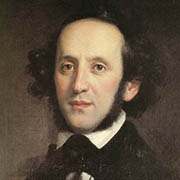In order to perform music of earlier centuries authentically, performers need to be familiar with the performance conventions of the day. A sensational discovery alters our view of Mendelssohn’s Violin Concerto.
Mendelssohn’s Violin Concerto was enthusiastically received by contemporaries, and quickly became one of the most frequently played of all violin concertos – a position which it has retained to the present day. Over the years however, styles of performing it have changed radically. Until the death of Joseph Joachim in 1907 a performing tradition associated directly with the composer remained in living memory. During the twentieth century, however, many aspects of performing style that had been integral to the musicianship of Mendelssohn, Schumann, Brahms, and their contemporaries were forgotten or rejected as a result of such disparate phenomena as ‘modernism’, the influence of recording, the evolution of a ‘modern baroque’ style of performance and many other factors that stimulated stylistic change. The manner in which the Violin Concerto is conventionally played today would undoubtedly have astonished, puzzled, and perhaps horrified Felix Mendelssohn and the work’s earliest performers: Ferdinand David, Hubert Léonard, and Joseph Joachim. Many of the practices they would have considered essential to a faithful rendering of the notation play little or no part in modern performance.
It is all too easy to assume that because nineteenth-century notation is so familiar it conveys more or less exactly the same messages to us as it did to Mendelssohn and his contemporaries. Musicians trained since the mid twentieth century, however, are almost entirely out of touch with the musicianship of the mid nineteenth century. A key tenet of the aesthetic with which we have grown up is that, in Classical and Romantic music, respect for the composer’s intentions demands a close adherence to the literal meaning of the notation, neither adding nor altering anything significantly. But in the light of historical evidence it has become increasingly clear that there are substantial differences between nineteenth-century composers’ intentions for the notation of their music and their expectations for its execution by a skilled musician. Respect for the composer’s notation, therefore, does not mean taking it at face value; in fact, to do so is a violation of the composer’s intentions.
If we truly want to respect the composer’s intentions, we need to rediscover the practices that were once central to beautiful music making, which were inherent in the notation but were, as Joseph Joachim put it, only to be ‘read between the lines’. To do this we can call upon a wealth of evidence from treatises, from contemporary accounts of performances as well as other documentary evidence, and especially from the markings of important nineteenth-century violinists, either printed or handwritten in musical sources. In the case of Mendelssohn’s Violin Concerto we have numerous bowed and fingered editions by leading musicians of the time. Among these are those of Ferdinand David and Joseph Joachim. And now, through a recent discovery in the library of the Royal Conservatories of Brussels, we also have a proof copy of the solo part, which Hubert Léonard marked up in great detail before playing it with the composer at the piano. All three of these sources document a similar style of performance, which is also reflected in other early editions of the work.
Interpreting the content of historical performing editions requires substantial understanding of the fingering and bowing practices of the period in which they were produced. In a booklet accompanying the edition, therefore, I offer information about the implications of historical performance markings, and the kinds of performing practices Mendelssohn expected, while in the edited solo part I include bowing and fingering that reflects the practices of the earliest performers. The edition also includes a detailed commentary, containing all the specific historical information I could find about performing practices in the Violin Concerto during the first sixty years of its existence.
Clive Brown
(from [t]akte 1/2018)



